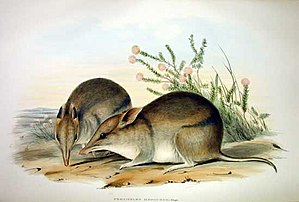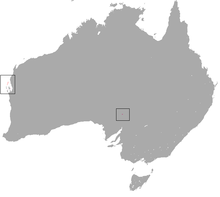Striped long-nosed bag
| Striped long-nosed bag | ||||||||||||
|---|---|---|---|---|---|---|---|---|---|---|---|---|

Stripe long-nosed bucket ( Perameles bougainville ), drawing by John Gould |
||||||||||||
| Systematics | ||||||||||||
|
||||||||||||
| Scientific name | ||||||||||||
| Perameles bougainville | ||||||||||||
| Quoy & Gaimard , 1824 |

The striped long-nosed buccaneer ( Perameles bougainville ) is a marsupial from the genus of the long-nosed buccaneer , which is now only found in two protected areas, in the Bernier and Dorre Island Nature Reserve in Shark Bay off the west coast of Australia and since 2000 also in the 60 km² Arid Recovery Project Area near Roxby Downs in South Australia .
features
The long-nosed striped pouch reaches a head body length of 17.3 to 22.6 cm, has a 8.1 to 10.6 cm long tail and a weight of 165 to 300 g. Adult females are on average 9.3% heavier and larger than the males, which is an exception for the nasal sacs. The information applies to the nominate form that lives on the islands of Bernier and Dorre. The extinct subspecies Perameles bougainville fasciata , formerly found in mainland Australia, was larger. The fur is gray-brown on the head, on the back and on the sides of the body. The peritoneum and the front and rear paws are whitish or cream-colored. On the rear flanks, the animals show a pattern of alternating light and dark stripes. The muzzle is long and pointed and the ears are pointed and are usually held upright. The tail base, where the animals can store fat reserves, is sometimes thickened. Compared to the extinct desert long-nosed pouch ( Perameles eremiana ), the fur of the striped long-nosed pouch is grayer, the tail is shorter and the feet are less hairy.
Occurrence and way of life
The striped long-nosed poult occurs on the islands of Bernier and Dorre in coastal bushland, on the beaches and in the interior of the island, with the interior of the island being covered with grasses growing in large tufts. The species was once widespread on the Australian mainland and was found in areas with sandy or stony subsoil, in open bushland and open forest areas, in thickets of allocasuarina and in gallery forests. The distribution area reached from Onslow in Western Australia over the Nullarbor Plain and southern South Australia to the west of New South Wales and the northwest of Victoria . The animals are nocturnal and spend the day in nests made of dry grass and leaves. In winter the animals are active until dawn, in summer they visit their nests a few hours before sunrise. Like the other nasal sacs, the large long-nosed sacrum feeds primarily on insects and other invertebrates, fruits and seeds. It also eats small vertebrates. Prey living in the ground is sniffed out and dug up with the strong front paws. The striped long-nosed bag leaves characteristic, conical holes in the ground that can be 20 to 25 cm deep.
Reproduction
On the islands, the female gives birth to one to three young per litter, which are mostly born in the winter months between March and October. On the mainland, there can also be four pups born between May and August. Larger females have more pups. There are eight teats arranged in a circle in the bag. A female can give birth twice a year. The mortality among young animals is high. Females reach sexual maturity at three to five months, while males take one month longer to reach sexual maturity. On the islands, the animals can live to be more than four years old.
Danger
According to the IUCN , the species is endangered ( Vulnerable ). It only occurs in two protected areas, where the populations are self-sustaining, but are subject to strong fluctuations due to the dry climate. The main reason for the extinction on the mainland was probably hunting by introduced red foxes, domestic dogs and domestic cats.
Individual evidence
- ↑ a b c d Christopher Dickman: Family Peramelidae (Bandicoots and Echymiperas). P. 391 in Don E. Wilson , Russell A. Mittermeier : Handbook of the Mammals of the World - Volume 5. Monotremes and Marsupials. Lynx Editions, 2015, ISBN 978-84-96553-99-6
- ↑ a b Perameles Bougainville in the Red List of Threatened Species of the IUCN 2016. Posted by: Burbidge, AA & Woinarski, J., 2014. Accessed April 5 2018th
